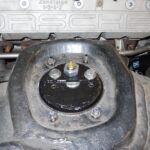You know you need to pass an emissions test to keep your car legal on the road, but have you ever stopped to think about why? Beyond just ticking a box for registration, your car’s emission control system plays a vital role in reducing harmful pollutants released into the air. These systems are complex, made up of various parts working together, including one component with a rather spooky-sounding name. Let’s explore this system and uncover which “spooky-sounding” car part is a key player in keeping our air cleaner.
The Exhaust Manifold: The Emission Control Journey Begins
The journey of emission control starts right at the engine with the exhaust manifold. Bolted directly to the engine block, this component acts as the collection point for exhaust gases exiting each cylinder. Imagine it as the first funnel, gathering all the byproducts of combustion. Within the manifold, initial noise reduction happens, and importantly, the air-fuel ratio begins to be assessed. The hot exhaust gases also start their cooling process here.
A damaged exhaust manifold, such as one with cracks, will create noticeable symptoms. You might hear a louder engine than usual, and even feel excessive heat radiating through the floor of your car. Some drivers also report a shaking gas pedal. Ignoring a damaged manifold is not wise as it can lead to more serious issues, including damage to the catalytic converter. Crucially, within the manifold are oxygen sensors. These sensors are vital for monitoring the air-fuel mixture. If the mixture is off, these sensors send signals to the engine’s computer, prompting adjustments to either increase or decrease fuel delivery to the combustion chamber. Maintaining the correct air-fuel balance is essential for optimal engine performance, fuel efficiency, and minimizing harmful emissions. If you notice a sudden drop in your car’s gas mileage, it’s worth having a mechanic check your oxygen sensors.
Catalytic Converter: Transforming Harmful Gases
Moving further down the exhaust stream, we encounter the catalytic converter. Positioned between the exhaust manifold and the muffler, the catalytic converter is a crucial component in cleaning up exhaust gases. Its primary function is to convert harmful hydrocarbons and carbon monoxide into less harmful carbon dioxide and water vapor. Inside the converter, a honeycomb structure coated with platinum and/or palladium acts as a catalyst. As the toxic gases pass through this honeycomb, they undergo oxidation, transforming into these less harmful components.
A malfunctioning catalytic converter or a leak in the exhaust pipe leading to it can have serious health consequences. If you or your passengers experience symptoms like weakness, dizziness, or nausea while in your car, a carbon monoxide leak should be suspected. Carbon monoxide is an odorless, colorless gas, and inhaling it is dangerous, even deadly in high concentrations. Immediate inspection of the catalytic converter and related piping is necessary if these symptoms arise.
The EGR Valve: That Spooky-Sounding Emission Controller
Now, for the “spooky-sounding” part we’ve been hinting at – the EGR valve. EGR stands for Exhaust Gas Recirculation, and the name itself might sound a bit mysterious to those unfamiliar with car mechanics. The EGR valve’s job is to recirculate a small portion of exhaust gas back into the engine’s intake manifold. Why would you want to put exhaust gas back into the engine? The key reason is to lower the combustion chamber temperature. Lowering this temperature is crucial because it reduces the formation of nitrogen oxides (NOx), which are significant air pollutants. By reducing NOx, the EGR valve plays a vital role in cleaner emissions.
Furthermore, this lower temperature also helps prevent engine knocking, also known as early detonation. Engine knocking occurs when the air-fuel mixture ignites prematurely in the cylinder, causing the pistons to move improperly and potentially damaging engine components. If you hear a rhythmic pinging or knocking sound coming from your engine, especially during acceleration, a faulty EGR valve could be the culprit.
In conclusion, emission control systems are not just about passing tests for vehicle registration; they are fundamental to vehicle performance, fuel efficiency, and crucially, the health and safety of both vehicle occupants and the environment. If you suspect any issues with your car’s emission system, it’s essential to have it inspected and repaired promptly by a qualified mechanic. Addressing these problems ensures your car runs efficiently, reduces pollution, and keeps you safe from harmful exhaust gases.
